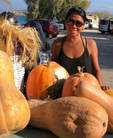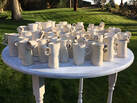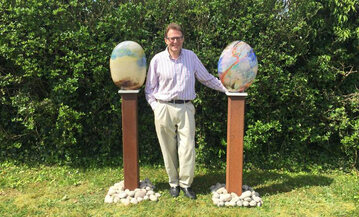
Adam Aaronson
Adam specialises in free blown glass. His vessels and sculptures are at once a celebration of the simplicity of pure form, and also an investigation into layering. His coloured patinas draw on painterly techniques and are predominately inspired by a love of nature, especially the play of light on water and the landscape. He has been commissioned to make work for the Royal Academy of Arts in London, Italy’s venerable Salviati glass studio, the Museum of Art and Design in New York, the UK’s National Art Collections Fund and The British Museum, among others. Shown at the prestigious Sotheby’s Contemporary Decorative Arts exhibition, London, and the Cooper Hewitt, Smithsonian Design Museum, in New York City. Adam is a Fellow of The Royal Society of Arts (FRSA)
Adam specialises in free blown glass. His vessels and sculptures are at once a celebration of the simplicity of pure form, and also an investigation into layering. His coloured patinas draw on painterly techniques and are predominately inspired by a love of nature, especially the play of light on water and the landscape. He has been commissioned to make work for the Royal Academy of Arts in London, Italy’s venerable Salviati glass studio, the Museum of Art and Design in New York, the UK’s National Art Collections Fund and The British Museum, among others. Shown at the prestigious Sotheby’s Contemporary Decorative Arts exhibition, London, and the Cooper Hewitt, Smithsonian Design Museum, in New York City. Adam is a Fellow of The Royal Society of Arts (FRSA)

Marie Ackers
My inspiration comes from various sources from the "French animalier" to the simplicity and purity of Brancusi's work, the shapes and presence of Henry Moore sculptures, the sharp and clean lines of Calder metal sculptures as well as Pompom, Lynn Chadwick, architecture old and modern. My work is sometimes compared to Art Deco or to Etruscan style but this is not the case at all. My main concerns for my work are lines, Balance , rhythm and colour. I have been working on those lines for a while now and most of my work devices from studies and sketches not a particular art genre or style.
My inspiration comes from various sources from the "French animalier" to the simplicity and purity of Brancusi's work, the shapes and presence of Henry Moore sculptures, the sharp and clean lines of Calder metal sculptures as well as Pompom, Lynn Chadwick, architecture old and modern. My work is sometimes compared to Art Deco or to Etruscan style but this is not the case at all. My main concerns for my work are lines, Balance , rhythm and colour. I have been working on those lines for a while now and most of my work devices from studies and sketches not a particular art genre or style.
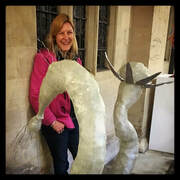
Roslin Adamson
Born and raised in South Africa, I studied Fine Art at the University of Cape Town, then spent 8 years teaching English in Japan. I returned to South Africa to study science and then came to Oxford to do a DPhil in Structural Biology, a branch of biochemistry that studies the structures of proteins. I have been making art again for the past several years, and feel that, in many ways, my day job as a researcher informs my art, and the other way round too, particularly in terms of concepts of scale.

Nicola Axe
I often chose to carve Portland stone for its hardness, fine grain texture and whiteness.
Incorporating crystals, fossils or handmade glass where relevant…..
The material is challenging but the process is deeply fulfilling. It connects me to the Earth and an ancient form of expression and creativity, leading to the exploration of the self.
I often chose to carve Portland stone for its hardness, fine grain texture and whiteness.
Incorporating crystals, fossils or handmade glass where relevant…..
The material is challenging but the process is deeply fulfilling. It connects me to the Earth and an ancient form of expression and creativity, leading to the exploration of the self.
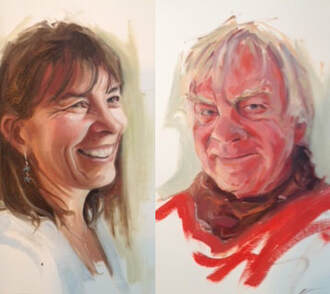
Richard Ballantyne & Carol Read
Richard started his artist career at Bradford college of Art. After a spell of destroying the character of a multitude of pubs and clubs in the north of England he returned to university at Bretton Hall to retrain as a teacher. His first teaching job he was put in charge of a ceramics department and so started at evening class to keep one step ahead of the children. This started a lifetime love affair with the material. In 2003 he left full time teaching, since then, he has worked full time in ceramics. Carol trained as a nurse after an education in both England, USA and Germany. Her interest in clay started at an evening Access to Art and Design course and developed a love of making- both on the wheel and hand building. Carol and Richard began a working partnership around 2010. Their ceramics are as varied as the British climate –work being both sculptural and functional, life size to miniature, Raku to high fired porcelain.Being not only pyromaniacs, but also collectors from woods, beaches and salvage yards, often the work incorporates found objects in the sculpture- from ash from Mount St Helens in a glaze to stones washed on the beach as plinths- each object telling its own story.
Richard started his artist career at Bradford college of Art. After a spell of destroying the character of a multitude of pubs and clubs in the north of England he returned to university at Bretton Hall to retrain as a teacher. His first teaching job he was put in charge of a ceramics department and so started at evening class to keep one step ahead of the children. This started a lifetime love affair with the material. In 2003 he left full time teaching, since then, he has worked full time in ceramics. Carol trained as a nurse after an education in both England, USA and Germany. Her interest in clay started at an evening Access to Art and Design course and developed a love of making- both on the wheel and hand building. Carol and Richard began a working partnership around 2010. Their ceramics are as varied as the British climate –work being both sculptural and functional, life size to miniature, Raku to high fired porcelain.Being not only pyromaniacs, but also collectors from woods, beaches and salvage yards, often the work incorporates found objects in the sculpture- from ash from Mount St Helens in a glaze to stones washed on the beach as plinths- each object telling its own story.
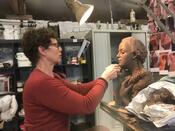
Christine Baxter
Many of my family members have been artists, there have been wrought iron gate makers, dress designers, wood carvers, sculptors, landscape designers, photographers and cooks. Making things is in my genes, but I have also benefited from growing up in an art nurturing environment.
My earliest memories are of drawing and sculpting with my grandfather.
Many of my family members have been artists, there have been wrought iron gate makers, dress designers, wood carvers, sculptors, landscape designers, photographers and cooks. Making things is in my genes, but I have also benefited from growing up in an art nurturing environment.
My earliest memories are of drawing and sculpting with my grandfather.

Dick Budden
Dick Budden was born in Jersey Channel Islands in 1940 and educated at Kings Bruton and later Bournemouth Art College. He started freelancing as a sculptor for BBC TV for classic shows such as The Kenny Everett Television Show, Morcombe and Wise Show, Monty Pythons Flying Circus and The Lion, The Witch and The Wardrobe. In the early 70’s he married Mary Hall and moved from Shepherds Bush to Maidenhead and discovered Bray Studios and the Film Industry. Films include Alien, Empire Strikes Back, Force 10 from Navarone, Company of Wolves, Superman, Sleepy Hollow and Phantom of the Opera. During the mid 70’s he moved to Waltham St Lawrence to the wonderful Barn studio at Coltmans Farm. Although his commissions are mainly built in poystyrene his passion came from wood carving which in turn led to discovering Bronze casting and foundries. Dick Budden worked with Kenneth Armitage enlarging three of his marquettes using techniques used by the film industry and getting them cast into bronze.
Dick Budden was born in Jersey Channel Islands in 1940 and educated at Kings Bruton and later Bournemouth Art College. He started freelancing as a sculptor for BBC TV for classic shows such as The Kenny Everett Television Show, Morcombe and Wise Show, Monty Pythons Flying Circus and The Lion, The Witch and The Wardrobe. In the early 70’s he married Mary Hall and moved from Shepherds Bush to Maidenhead and discovered Bray Studios and the Film Industry. Films include Alien, Empire Strikes Back, Force 10 from Navarone, Company of Wolves, Superman, Sleepy Hollow and Phantom of the Opera. During the mid 70’s he moved to Waltham St Lawrence to the wonderful Barn studio at Coltmans Farm. Although his commissions are mainly built in poystyrene his passion came from wood carving which in turn led to discovering Bronze casting and foundries. Dick Budden worked with Kenneth Armitage enlarging three of his marquettes using techniques used by the film industry and getting them cast into bronze.
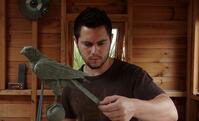
Elliot Channer
Elliot showed a passion for wildlife and art from a young age. Described as one of the 'young stars' of the international art fair circuit by Belgravia magazine and featured in many a glossy mag since. Elliot travels extensively in order to observe, photograph and sketch animals in their natural habitat.
Elliot showed a passion for wildlife and art from a young age. Described as one of the 'young stars' of the international art fair circuit by Belgravia magazine and featured in many a glossy mag since. Elliot travels extensively in order to observe, photograph and sketch animals in their natural habitat.
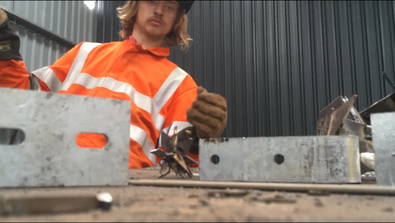
Freddie Churchill
My hands hurt, but it was totally worth it. Metal sculpture weaved its way into my life about 2 years ago and i have not stopped ever since. Forging a sculpture with just your body is a visceral experience, you really feel the struggle in the creative process. Jumping up and down on your sculpture brings you closer to your material in a very weird yet real way. I want to use my body to turn a lifeless, inanimate, artificial object into a living and moving creature. Using natural folds and dents gives it the tactility and look of paper when it is hard, exploring texture and life in something mankind has tried to tame gives me pleasure. Through my work i am allowing steel to be reclaimed by nature, as it rusts, it hides the initial shine of pure, controlled steel and reverts to it’s original form.
My hands hurt, but it was totally worth it. Metal sculpture weaved its way into my life about 2 years ago and i have not stopped ever since. Forging a sculpture with just your body is a visceral experience, you really feel the struggle in the creative process. Jumping up and down on your sculpture brings you closer to your material in a very weird yet real way. I want to use my body to turn a lifeless, inanimate, artificial object into a living and moving creature. Using natural folds and dents gives it the tactility and look of paper when it is hard, exploring texture and life in something mankind has tried to tame gives me pleasure. Through my work i am allowing steel to be reclaimed by nature, as it rusts, it hides the initial shine of pure, controlled steel and reverts to it’s original form.

Sarah Cox
Sarah trained at Central Saint Martins in ceramics. Her unique vibrantly coloured ceramics are hand built use slab and coil technique. Her work portrays happiness and humour and make her clients smile every time they see them in their gardens.

Richard Cresswell
I started my working life as a mechanical engineer designing all manner of things and creating beautiful prototypes which I enjoyed immensely but found after years of this that the only thing my clients were concerned with was costs and profit.
So I had a plan around 2001 to design my life in to something where I could throw all my passion in to my work and make only things I liked and hopefully gave others pleasure when they saw them, still working on it.
I started my working life as a mechanical engineer designing all manner of things and creating beautiful prototypes which I enjoyed immensely but found after years of this that the only thing my clients were concerned with was costs and profit.
So I had a plan around 2001 to design my life in to something where I could throw all my passion in to my work and make only things I liked and hopefully gave others pleasure when they saw them, still working on it.

Veronica Gosling
Veronica Gosling,was vaguely educated in America and England, worked as a journalist in Plymouth and Istanbul, published 5 novels, married psychoanalyst Robert Gosling,they had 5 children, lived in London before moving to the forest of Dean where she took up sculpture, assemblage and pottery decoration. They started and ran an informal gallery, THE BARN AT HAY FARM, inviting other artists to show imaginative and experimental work. She moved to Exeter several years ago and set up Studio 36 with similar emphasis, and relates to discarded objects, including bicycles (which can be seen hanging from trees) and organises occasional fun and experimental events collaborating with interesting writers, sailors, artists, and musicians and is open to further ideas!
Veronica Gosling,was vaguely educated in America and England, worked as a journalist in Plymouth and Istanbul, published 5 novels, married psychoanalyst Robert Gosling,they had 5 children, lived in London before moving to the forest of Dean where she took up sculpture, assemblage and pottery decoration. They started and ran an informal gallery, THE BARN AT HAY FARM, inviting other artists to show imaginative and experimental work. She moved to Exeter several years ago and set up Studio 36 with similar emphasis, and relates to discarded objects, including bicycles (which can be seen hanging from trees) and organises occasional fun and experimental events collaborating with interesting writers, sailors, artists, and musicians and is open to further ideas!
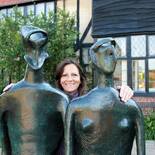
Lilly Henry
Inspired by nature I became an avid collector of pebbles and flints, feathers and gnarled wood finding a life force within them that fascinated me.
In 2010 I was introduced to one of Henry Moores technicians who guided me and mentored me for three years in the art of carving.
This knowledge gave me the freedom to re create my smaller maquettes and found objects into large sculptural forms.
Inspired by nature I became an avid collector of pebbles and flints, feathers and gnarled wood finding a life force within them that fascinated me.
In 2010 I was introduced to one of Henry Moores technicians who guided me and mentored me for three years in the art of carving.
This knowledge gave me the freedom to re create my smaller maquettes and found objects into large sculptural forms.
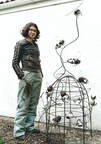
Victoria Hunt
I work mostly with insect forms, fish and flowers, using a distinctive mix of rod, industrial construction fixings and cutlery. I enjoy the challenge of working with existing materials, with their inherent properties, and using them to new effect in my pieces. I like the two tone effect of the bright silver stainless steel and the brown, weathered mild steel, contrasting with the highly reflective cutlery. My style varies from the lyrical and elegant, to the quirky and fun.
I work mostly with insect forms, fish and flowers, using a distinctive mix of rod, industrial construction fixings and cutlery. I enjoy the challenge of working with existing materials, with their inherent properties, and using them to new effect in my pieces. I like the two tone effect of the bright silver stainless steel and the brown, weathered mild steel, contrasting with the highly reflective cutlery. My style varies from the lyrical and elegant, to the quirky and fun.
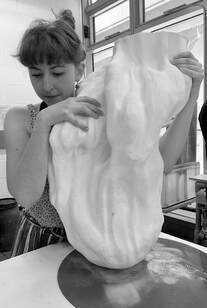
Emily Stapleton-Jefferis
Emily Stapleton-Jefferis (b.1992) is an artist living and working in London. She works between drawing and making, with a particular focus on the use of clay. Craft skills remain integral to Emily’s practice as she pushes her material knowledge to pursue an excellence of making. She believes in the importance of hand-crafting, with such an act responding to our innate creative nature, often forgotten as our daily lives become increasingly digital. Her sculptural work primarily involves clay which she is drawn to as a result of its plasticity, tactility and intimacy within our daily lives. The rich history of ceramics, the very fact it lies beneath our feet, and the transformative qualities of the material are also a constant source of inspiration. Emily’s current work draws upon the materiality of clay to explore states of flux and growth. “These sculptures come together to form a strange landscape, a bizarre dreamscape in which the works feels simultaneously familiar and alien. I am interested in exploring this tension and creating work which both confuses and comforts. Which seems caught in the act of becoming, and remains uncertain. Forms refer to both the anatomical and to the botanical, to the micro and the macro, to both our own landscapes and science-fictional worlds. Echoes of my touch remain embedded in the work, with my entire body involved in the shaping, and forming and moulding. My hands acting to channel my unconscious into physical form.”
Emily Stapleton-Jefferis (b.1992) is an artist living and working in London. She works between drawing and making, with a particular focus on the use of clay. Craft skills remain integral to Emily’s practice as she pushes her material knowledge to pursue an excellence of making. She believes in the importance of hand-crafting, with such an act responding to our innate creative nature, often forgotten as our daily lives become increasingly digital. Her sculptural work primarily involves clay which she is drawn to as a result of its plasticity, tactility and intimacy within our daily lives. The rich history of ceramics, the very fact it lies beneath our feet, and the transformative qualities of the material are also a constant source of inspiration. Emily’s current work draws upon the materiality of clay to explore states of flux and growth. “These sculptures come together to form a strange landscape, a bizarre dreamscape in which the works feels simultaneously familiar and alien. I am interested in exploring this tension and creating work which both confuses and comforts. Which seems caught in the act of becoming, and remains uncertain. Forms refer to both the anatomical and to the botanical, to the micro and the macro, to both our own landscapes and science-fictional worlds. Echoes of my touch remain embedded in the work, with my entire body involved in the shaping, and forming and moulding. My hands acting to channel my unconscious into physical form.”

Peter King
I’ve had great success with my botanical sculptures over recent years. This year it's 21 I've been bashing away in my workshop.
Bursts of manic action. Tidy workshop. Knock down (wasted space) storeroom and build shelves. Start to repair broken concrete floor and end up re covering the whole thing. Workspace and head nearly clear now. Almost ready to hit things again in a more fanciful way.
Now in my 50s it is time to let the spirit grow, not be afraid of doing something different, understandings of nature.
Keep the flowers, re connect with abstraction, a little colour again? Yes time to let the spirit fly.
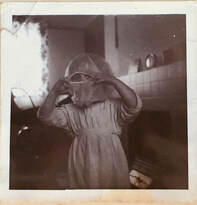
June Kingsbury
I am nearly three years old. My father is carrying me on his shoulders down to the river to feed the swans. I walk part of the way and fill my pockets with banded snails, Cepaea Hortensis. Feathers. Small treasures. My father was for a time a shepherd. We learn the names of the trees, of the flowers and birds. My mother collected the broken glass from church windows, my grandfather a glassblower in the Netherlands. I am half Dutch. Stories of war and of loss. I am half English, trout swimming, birds singing, summer green and endless, leaves falling in autumn. In my pocket, a leaf, the brilliant iridescent blue banded feather of a jay. In my hands a memory. On the table an accumulation of small treasures. Poetry stones of clay, creatures of the forest, antlers, a wren. Windows of brilliant cast glass - colour, diamonds of light. By my side my granddaughter, small stones, a leaf, a feather
I am nearly three years old. My father is carrying me on his shoulders down to the river to feed the swans. I walk part of the way and fill my pockets with banded snails, Cepaea Hortensis. Feathers. Small treasures. My father was for a time a shepherd. We learn the names of the trees, of the flowers and birds. My mother collected the broken glass from church windows, my grandfather a glassblower in the Netherlands. I am half Dutch. Stories of war and of loss. I am half English, trout swimming, birds singing, summer green and endless, leaves falling in autumn. In my pocket, a leaf, the brilliant iridescent blue banded feather of a jay. In my hands a memory. On the table an accumulation of small treasures. Poetry stones of clay, creatures of the forest, antlers, a wren. Windows of brilliant cast glass - colour, diamonds of light. By my side my granddaughter, small stones, a leaf, a feather

Ama Menec
After 30+ years as a ceramicist Ama Menec is currently building up a new body of work in limited edition, patinated foundry bronze, on her twin themes of ancient and natural history. Her natural history projects include a Buzzard, Red Kite, Swift and Badger with a Barn Owl, Fox and Kingfisher on the way. She is also working on a complex ecological sculpture of a Badger Trophic Cascade; the consequence of widespread badger culling. Her historical projects include a wall hanging bronze of Hypnia and currently a public statue of the UKs first out lesbian, from the Regency era, Anne Lister of Shibden Hall.
After 30+ years as a ceramicist Ama Menec is currently building up a new body of work in limited edition, patinated foundry bronze, on her twin themes of ancient and natural history. Her natural history projects include a Buzzard, Red Kite, Swift and Badger with a Barn Owl, Fox and Kingfisher on the way. She is also working on a complex ecological sculpture of a Badger Trophic Cascade; the consequence of widespread badger culling. Her historical projects include a wall hanging bronze of Hypnia and currently a public statue of the UKs first out lesbian, from the Regency era, Anne Lister of Shibden Hall.

Nicolas Moreton
Stone is stuff from which the British sculpture tradition is hewn. Bronze and wood, steel and the junk of mass consumerism, film and video even have all played a part but the roots of the sculpture in this country are rock solid. It's a story that weaves its way from grandeur of ancient standing stones to the delicacy of ecclesiastical carvings and on to beginnings of modernism and the celebration of what Moore and Hepworth called "truth to materials". Nicolas Moreton is a modern master of the medium of stone-carving but with a strong sense of tradition. His work somehow suggests the primordial power of the stuff with which he wrestles so deftly but has much of the subtlety of the great but anonymous stone-masons of the thirteenth and fourteenth centuries where one material seems transformed into another before our eyes. His current project promises to be a National Stone Carving Tour de Force. On one level it takes sculpture back into the past and offers the chance - without hubris - to compare the traditional with the contemporary; on another, it promises to be a vast and ambitious performance - where the private world of the studio is made public and the mysteries - not to mention the sheer physical effort of working the stone - are laid bare. Tim Marlow. Art Critic and Director of Exhibitions for the White Cube Gallery. London.
Stone is stuff from which the British sculpture tradition is hewn. Bronze and wood, steel and the junk of mass consumerism, film and video even have all played a part but the roots of the sculpture in this country are rock solid. It's a story that weaves its way from grandeur of ancient standing stones to the delicacy of ecclesiastical carvings and on to beginnings of modernism and the celebration of what Moore and Hepworth called "truth to materials". Nicolas Moreton is a modern master of the medium of stone-carving but with a strong sense of tradition. His work somehow suggests the primordial power of the stuff with which he wrestles so deftly but has much of the subtlety of the great but anonymous stone-masons of the thirteenth and fourteenth centuries where one material seems transformed into another before our eyes. His current project promises to be a National Stone Carving Tour de Force. On one level it takes sculpture back into the past and offers the chance - without hubris - to compare the traditional with the contemporary; on another, it promises to be a vast and ambitious performance - where the private world of the studio is made public and the mysteries - not to mention the sheer physical effort of working the stone - are laid bare. Tim Marlow. Art Critic and Director of Exhibitions for the White Cube Gallery. London.
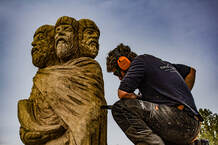
Simon O'Rourke
I’m Simon O’Rourke, an artist working out of North Wales. I create sculptures with a chainsaw that beautifully compliment their surroundings and enhance gardens, homes, and public or commercial spaces. My chainsaw carving exploits have taken me all around the world. I produce fine pieces of artwork using waste timber or standing stumps, using a variety of power tools and hand tools. These works of art range from classical sculpture of human and animal form, to abstract work and re-creating logos in wood.
I’m Simon O’Rourke, an artist working out of North Wales. I create sculptures with a chainsaw that beautifully compliment their surroundings and enhance gardens, homes, and public or commercial spaces. My chainsaw carving exploits have taken me all around the world. I produce fine pieces of artwork using waste timber or standing stumps, using a variety of power tools and hand tools. These works of art range from classical sculpture of human and animal form, to abstract work and re-creating logos in wood.

Jenny Pickford
Jenny Pickford is a contemporary artist blacksmith designing and making unique sculptures, water features and architectural ironwork from her forge. Jenny exhibits throughout the UK and Internationally and exports her work to clients across the Globe. She exhibited at the RHS Chelsea Flower Show from 2005-2015, installed her ‘Agapanthus’ sculpture as show feature at the Chicago Flower Show in 2012, had solo shows in National Trust gardens in 2015, 2017, 2018. You can view her public art commissions in China, Australia the USA and across Europe.
Jenny Pickford is a contemporary artist blacksmith designing and making unique sculptures, water features and architectural ironwork from her forge. Jenny exhibits throughout the UK and Internationally and exports her work to clients across the Globe. She exhibited at the RHS Chelsea Flower Show from 2005-2015, installed her ‘Agapanthus’ sculpture as show feature at the Chicago Flower Show in 2012, had solo shows in National Trust gardens in 2015, 2017, 2018. You can view her public art commissions in China, Australia the USA and across Europe.
|
Jennie Roberts
Jennie works as an Artist using household paint as a medium. In 2018 she was commissioned to paint an 8m mural wall in France (AID Interiors). She has exhibited at Henley Festival, John Lewis High Wycombe and Open Studios at her home in Penn. She fell in love with claywork. In 2018 she started handbuilding vessels with a quirky handles, rolling out clay flat like pastry. This became an engaging and repetitive process. Described by admirers as ‘raw’ and ‘seemingly unfinished’ these works possess a charm similar to Edmund de Waals porcelain vessels. The installation she is showing came about unintentionally. As vessels emerge from the kilm they were randomly placed on the only surface available in her studio – on a circular table. It was the passing positive comments of friends that encouraged Jennie to exhibit the installation for the first time. |
|

Guy Routledge
Guy studied glass and ceramics at Sunderland University. His work is based loosely on the figure, head and animals; each of which he gives a unique character. All the work is hand built, either by coiling, slabbing or press moulding, mixed glazes and firings.
Guy studied glass and ceramics at Sunderland University. His work is based loosely on the figure, head and animals; each of which he gives a unique character. All the work is hand built, either by coiling, slabbing or press moulding, mixed glazes and firings.
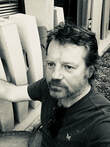
Stuart Stockwell
Stuart Stockwell is a kinetic sculptor based in Cheltenham creates unique sculptures that capture attention and engage the imagination through simple design and movement. Stuart’s sculptures interpret nature’s genius; a balance of complex function and simplistic beauty, inspired by organic forms and sacred geometry. His pieces are multi-layered and deconstructed. They incorporate metals and concrete – materials taken from the earth – and refine them into elegant curves which give them feeling of movement in static rest. All of his pieces create a union between modern design and nature, blending fluidly with their surrounding environment and elements.
Stuart Stockwell is a kinetic sculptor based in Cheltenham creates unique sculptures that capture attention and engage the imagination through simple design and movement. Stuart’s sculptures interpret nature’s genius; a balance of complex function and simplistic beauty, inspired by organic forms and sacred geometry. His pieces are multi-layered and deconstructed. They incorporate metals and concrete – materials taken from the earth – and refine them into elegant curves which give them feeling of movement in static rest. All of his pieces create a union between modern design and nature, blending fluidly with their surrounding environment and elements.
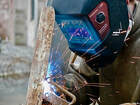
Harrison Warren
I am a sculptor currently living in Wales and I take my inspiration from science and nature, in particular; naturally occurring patterns and phenomena. A great appreciation for the outdoors and natural beauty drove me to mimic the world around me in a number of different materials and methods but working mostly in metal.
I am a sculptor currently living in Wales and I take my inspiration from science and nature, in particular; naturally occurring patterns and phenomena. A great appreciation for the outdoors and natural beauty drove me to mimic the world around me in a number of different materials and methods but working mostly in metal.

David Watkinson
Kinetic art is my passion, it allows me to create sculpture that interacts in a harmonious way with the world, it is almost a life form; it is controlled yet beyond my control. It allows the viewer to see the wind, to watch gravity in action and as the sculpture faithfully obeys the laws of physics, it is a reminder that we are part of a greater Universe.
Kinetic art is my passion, it allows me to create sculpture that interacts in a harmonious way with the world, it is almost a life form; it is controlled yet beyond my control. It allows the viewer to see the wind, to watch gravity in action and as the sculpture faithfully obeys the laws of physics, it is a reminder that we are part of a greater Universe.
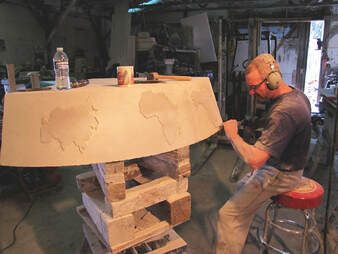
Martin Williams
After completing graduate and post-graduate training in Stoke-on-Trent and London, I established my first studio in Swansea, South Wales, in 1978. I won several major commissions including a series of relief panels for a waterside site in Cardiff, and a large continuous relief work in Woolwich Arsenal Station in London. This was one of the largest ceramic relief works produced in the UK in the 20th Century. In time, it became more difficult to realise my sculptural ambitions using fired clay as a finished sculptural material, and I began to design and form sculpture in steel, bronze & stone. I have now worked extensively with these materials, designing and making sculpture for the urban environment, and for my own development.As well as undertaking public commissions, I produce my own studio work in stone and bronze. Pieces are carved from Portland stone, and mounted on a base of Kilkenny limestone.
After completing graduate and post-graduate training in Stoke-on-Trent and London, I established my first studio in Swansea, South Wales, in 1978. I won several major commissions including a series of relief panels for a waterside site in Cardiff, and a large continuous relief work in Woolwich Arsenal Station in London. This was one of the largest ceramic relief works produced in the UK in the 20th Century. In time, it became more difficult to realise my sculptural ambitions using fired clay as a finished sculptural material, and I began to design and form sculpture in steel, bronze & stone. I have now worked extensively with these materials, designing and making sculpture for the urban environment, and for my own development.As well as undertaking public commissions, I produce my own studio work in stone and bronze. Pieces are carved from Portland stone, and mounted on a base of Kilkenny limestone.

